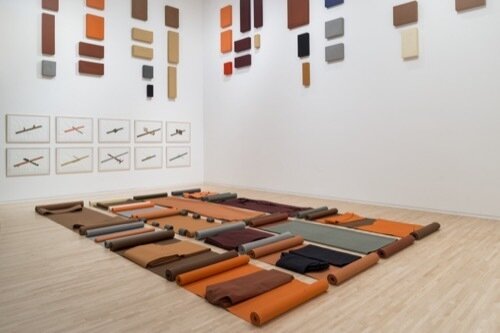Franz Erhard Walther
HENRY ART GALLERY
15th Avenue NE & NE 41st Street October 31–March 6
This review of Franz Erhard Walther: The Body Draws at the Henry Art Gallery was initially published on artforum - 01/02/2016
With its 300 works, “Franz Erhard Walther: The Body Draws”—the first American survey of the pioneering German artist—offers an interesting reassessment of his work. As the title suggests, the show is intended to consider the extent to which drawing—broadly speaking —has always been at the core of the artist’s practice. Focusing on works on paper, the extensive exhibition foregrounds the importance of the line, in a body of work at the crossroads of painting, sculpture, architecture, the conceptual, and the performative.
In the main room, Walther’s cornerstone piece, 1. Werksatz (1. Work Set, 1963–69), sits in the same state it occupied while in storage, letting viewers imagine what lies within canvas bags, within folds. Along the wall, videos show the unfolded fabric pieces being “activated”—a term Walther uses to describe the moments when these works are brought to life by being solemnly held or worn. Daily, volunteers activate some of these elements as well, as when a duo formed a line with the help of one of Walther’s long strips of fabric connecting the tops of their heads, or when four people quietly unfolded a cruciform piece of fabric. These activations remind viewers the work should be experienced with their participation.
In the 1970s, the artist revisited this iconic piece, through very realistic renderings of these activations, which are presented in the same room. Be it abstract or realistic, drawing is Walther’s way to remember, revisit, plan, or re-embody a work—and to expand a practice where the conceptual is absolutely incarnate. Through the exhibition’s seven rooms, the works on paper constantly dialogue with the sculptural elements, allowing viewers to sense—and take part in—Walther’s practice at its closest, to witness what the artist calls his “inner modeling” and be reminded that, as Michel Foucault put it in 1966, “the body is the zero point of the world.”
Anne Couillaud
